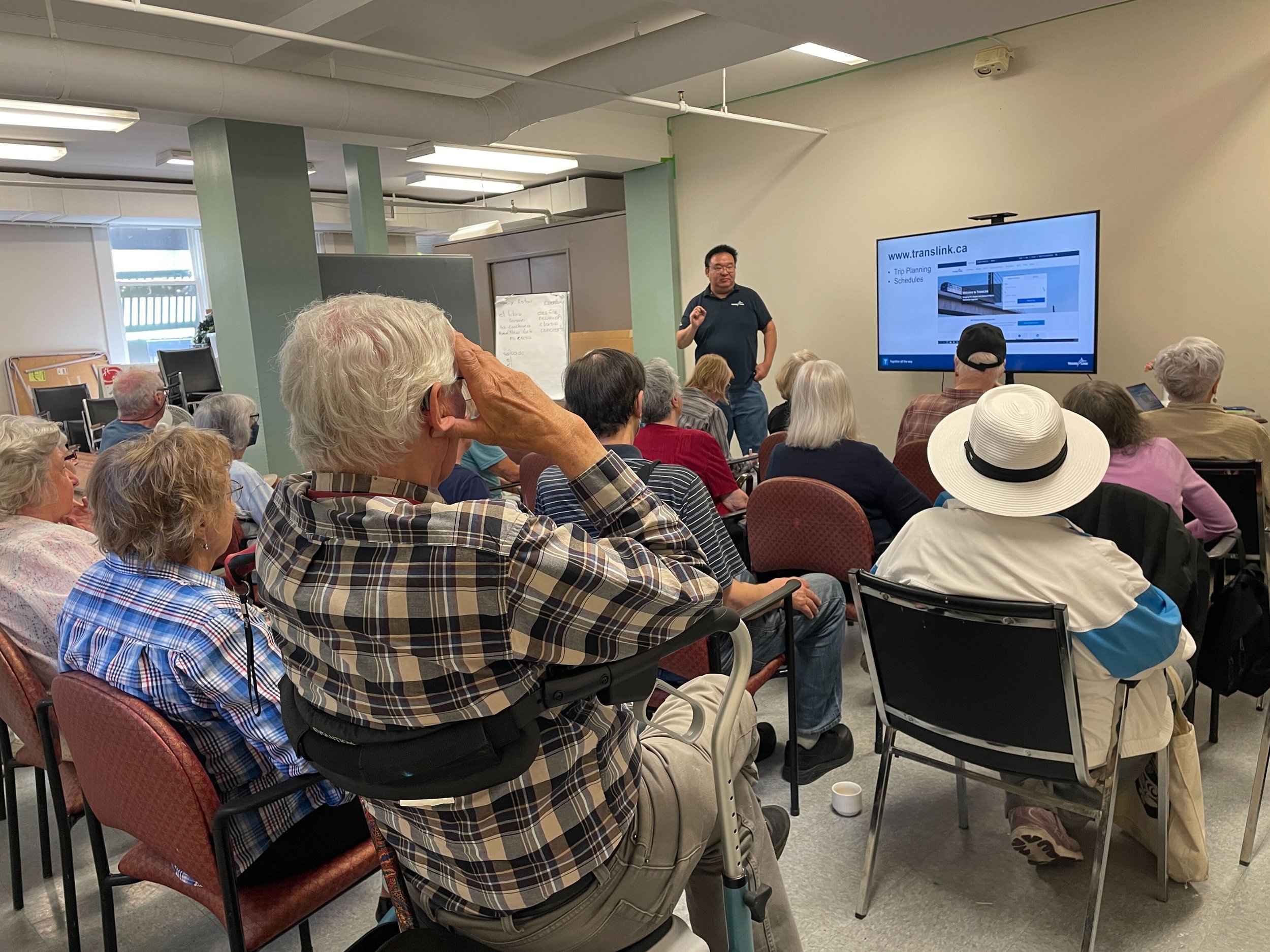
STORIES & NEWS
Why and How To Take Advantage of Your U-Pass
A universal pass, otherwise known as U-Pass, is a transit pass offered to students in post-secondary schools in BC. By offering this pass at a reduced cost for students, included in their tuition, Translink provides students with an affordable and sustainable method of transportation while attending school. While some students employ their U-Pass more than others, there are still ways for all students to take advantage of theirs; Which they should.
A universal pass, otherwise known as U-Pass, is a transit pass offered to students in post-secondary schools in BC. By offering this pass at a reduced cost for students, included in their tuition, Translink provides students an affordable and sustainable method of transportation while attending school. The use of a U-Pass differs for students depending on their situation; whether they live close to their campus or not, whether they have access to a car or not, and so on and so forth. While some students employ their U-Pass more than others, there are still ways for all students to take advantage of theirs; Which they should.
The Why
Cost Comparison: U-Pass vs. Adult Monthly Pass
The cost breakdown of a U-Pass is one of its main benefits to students. When you compare it to the cost of an adult monthly pass, the savings are significant. A U-Pass for a 4-month school term costs $180.40 for students, valid in all zones. On the other hand, an adult 3-zone monthly pass is $189.45. Isn’t that a crazy difference? A U-Pass valid for 4 months is cheaper than an adult pass that’s good for 1 month. Putting that into perspective, why wouldn’t you want to use your U-Pass while you can? When you don’t have access to the student pricing anymore, you’ll surely miss it.
Easily Allows for Multimodal Transportation
You can easily combine multiple forms of transportation in your commute by taking transit. Transiting often requires walking a bit to make it to a station or stop. Got your bike with you? No worries. If you can’t bike through a certain area, take it on transit with you. Buses have front racks to store your bike on the ride, and you can bring your bike on the SkyTrain and SeaBus as well. You’ve already combined 3 transportation methods for your commute. Multimodal transportation promotes active living and sustainability; who wouldn’t want that?
The How
Always Load Your U-Pass Each Month
Even if you don’t think you’ll use it, load your u-pass every month. First of all, it takes very little time to do so. You even get an email reminder when you can load it to your compass card. Think of it this way: you don’t usually take transit, but one night you go out with your friends. You’re in no position to drive home so you decide to transit, which is a good decision. However, you realize that you forgot to load your U-Pass this month. So you load it hoping it’ll work in time, but it doesn’t, and you end up having to pay the fare despite already having paid for your pass. Therefore, always make sure to load it so when you do need it, it’s accessible to you.
Take Advantage of No Time Limit
At the times when you might not have a U-Pass, you realize how fortunate you are to have a pass that doesn’t leave you constrained to 90-minute windows before you have to pay for transit fare again. With the U-Pass, you can tap in and out at whatever time you want for no additional cost. Whereas if you’re paying for regular fare, you pay once, and once it’s been 90 minutes since that initial tap, you’ll have to pay again. Rather than trying to rush so you don’t have to pay again, your U-Pass allows you to hang around campus, go out with friends, and take your time. Transit will be there when you’re done and at no additional cost.
Opt for Transit Over Driving Once in a While
Many students prefer driving over transiting when going to campus, which is understandable. It’s convenient, often quicker, and it’s more private. Despite these benefits, there are also some benefits in opting for transit. Not only that, since you’re already paying for a U-Pass you might as well use it once in a while. Taking transit allows you to explore the area by looking out the window on your bus/SkyTrain ride with no care for traffic, get some rest, and even get some work done for the class you’re about to attend. You can also skip out on the gas and parking costs you incur from driving, which tends to add up, especially on a student budget. Sometimes sitting on transit and taking in the area and people around you is much more peaceful than a traffic-filled car ride.
A U-Pass is one of the best perks you can get as a student attending post-secondary school in BC. The pricing is unmatched and the pass itself extends great benefits to students that can only be taken advantage of while in school. Not only that, but it’s a more sustainable transportation option in comparison to driving. To learn more about how to load or use your U-Pass, go to Translink’s U-Pass BC FAQ page.
Written by: Michelle Peng
Journey of Age: Navigating Transportation for Seniors in BC
One of our key initiatives, Seniors on the Move (SOTM), focuses on expanding transportation options for older adults in BC, enabling them to continue leading fulfilling lives even after they stop driving. We understand the emotional and practical challenges of ceasing to drive, and we aim to facilitate a smooth transition to a new chapter of mobility.
We want to highlight the vital role played by non-profit organizations like United Way BC and BEST (Better Environmentally Sound Transportation), along with our community partners, in assisting seniors in finding environmentally friendly alternative transportation options. Through initiatives such as carpools and community shuttle buses, we strive to support seniors in maintaining their mobility and independence while being mindful of the environment.
One of our key initiatives, Seniors on the Move (SOTM), focuses on expanding transportation options for older adults in BC, enabling them to continue leading fulfilling lives even after they stop driving. We understand the emotional and practical challenges of ceasing to drive, and we aim to facilitate a smooth transition to a new chapter of mobility.
In honour of BC Seniors' Week 2023, which took place from June 4-10, United Way BC and BEST collaborated with various organizations, including Ask Friendship Society, South Vancouver Neighborhood House, Richmond Care, Richmond Gives, Seniors Services Society of BC, Dunbar Residents' Association, West End Community Centre Association, Vancouver Cycling Without Age Society, Westside Seniors Hub, SHARE Family and Community Services, Brightside Community Homes Foundation, and Collingwood Neighborhood House. We are grateful for the generous support from Vancouver Coastal Health and Vantage Point. Together, we aim to profile and celebrate community champions who advocate for alternative forms of transportation!
Visit our website to see our posters and read the inspiring stories of seniors featured throughout June and July by clicking here. Not only that, but keep an eye out for our posters around the city, community libraries, senior serving agencies, and more! Here’s an example:
If you know a remarkable senior in our community who deserves recognition, we want to hear from you! Reach out to us with their story, and they could be featured in our campaign. Let's celebrate their achievements and amplify their voices! Thank you for your ongoing support as we work towards creating a more sustainable and inclusive transportation system for seniors in our community!
Our work doesn’t end there! SOTM has been having some other exciting things going on, and we are eager to share them with you!
Back in March, SOTM started Systems Mapping, a collaborative mobilization effort among partners in British Columbia with the shared goal of mobility and transportation justice, particularly those from equity-deserving groups. Facilitated by BEST and United Way BC, this participatory approach involves a series of strategic visioning sessions that collect voices and visions from representatives across BC to catalyze systemic social innovation toward mobility for all. We aim to form a community-informed collective path toward a user-centred, equitable, and well-integrated mobility and transportation system that caters to older people of all abilities, regions, and backgrounds in BC.
The hotter weather has quickly approached us and BEST is working on a solution for our seniors. With Cool Riders, we’re identifying “hotspots” in Vancouver to save seniors from the heat and transporting them to cooling centres during extreme heat events. By collaborating with local senior serving agencies, we hope for Cool Riders to be a pilot project and spread to neighbouring communities. Email us at SOTM@best.bc.ca to stay up to date with this initiative!
BEST has partnered with TransLink to offer transit training workshops specifically designed for seniors and equity-seeking populations. These workshops will help participants become familiar with the transportation systems in Vancouver, learn how to plan and gain confidence in using public transit. That’s not all! The training will also include excursions, allowing participants to put their newfound knowledge into practice while exploring the city! With the support and guidance of knowledgeable instructors, older adults can feel empowered to navigate Vancouver's transit system with ease and independence. Want to join? The next workshop is July 19th from 10:30 AM to 12 PM at South Granville Seniors Centre! Email us at SOTM@best.bc.ca if you’re interested!
R.O.V.I.N.G. (Raising Our Voices in Support of Non-Ageist Ways of Getting Around) is a short documentary presented by BEST through our SOTM initiative, which highlights challenges and opportunities for seniors' transportation in BC. R.O.V.I.N.G. demonstrates how transportation options play a key role in giving lives meaning and purpose, and how they contribute to health and well-being. Our goal is to create a platform for these important discussions to take place and to gather feedback that can help guide future advocacy efforts. We are committed to improving senior transportation and believe engaging in an open and honest dialogue is an essential first step. Missed the last few screenings? No worries! Our plan for this year is to provide community centres, libraries, and senior centres with the opportunity to watch our documentary and engage in meaningful community dialogues about the needs and challenges of senior transportation. Interested organizations can contact us directly at SOTM@best.bc.ca and we will provide the documentary along with a thoughtfully designed questionnaire.
If you are a senior or know a senior, feel free to join our Seniors On The Move Facebook group! We want to build a community where seniors or those caring for seniors can hear more about our initiatives and share anything they want as well. Join here: https://www.facebook.com/groups/seniorsonthemove.ca
Walk along Byrne Creek: A nature walk connected by zero-emission transit
Our weekly walking route starts on Edmonds and goes along Byrne Creek.
For this week’s walking route tour, we have a short and easy one for you. Tip: You might want to try it soon as some major changes are anticipated in the area. And this weekend is expected to be a beautiful sunny one too!
We begin the route at Edmonds SkyTrain station. Right now this route is quite a calming, but it might not be as quiet as you can expect the development of the new Southgate City - a pedestrian-friendly development - to start soon.
Speaking of future plans, this neighborhood will soon be home to the new Skytrain Control Centre but as of today, Edmonds station and bus loop has a unique design. Westbound trains platforms are at street level and the bus stop is located in a convenient roundabout. The bus shelters share an interesting display that congregates all waiting passengers at the same location in the middle of the circle.
There are several options to walk around the station, but we chose to go down on Station Hill Drive towards the BC Parkway.
We crossed to the Parkway and walked along the paved trail. Did you know that this is a pedestrian and bike lane connecting Edmonds to Downtown New West? It’s a long walk (1 hour+) to downtown, but quite inviting we must say.
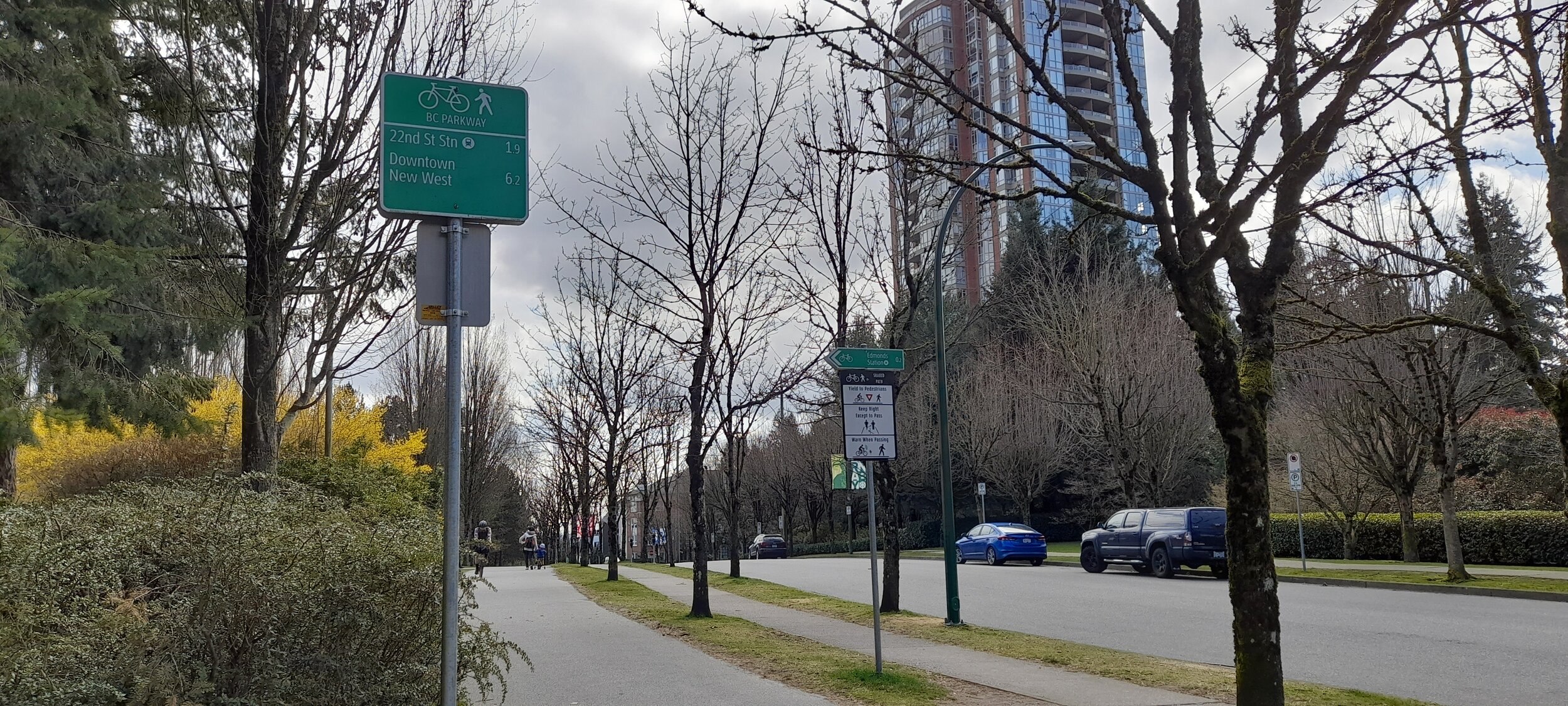
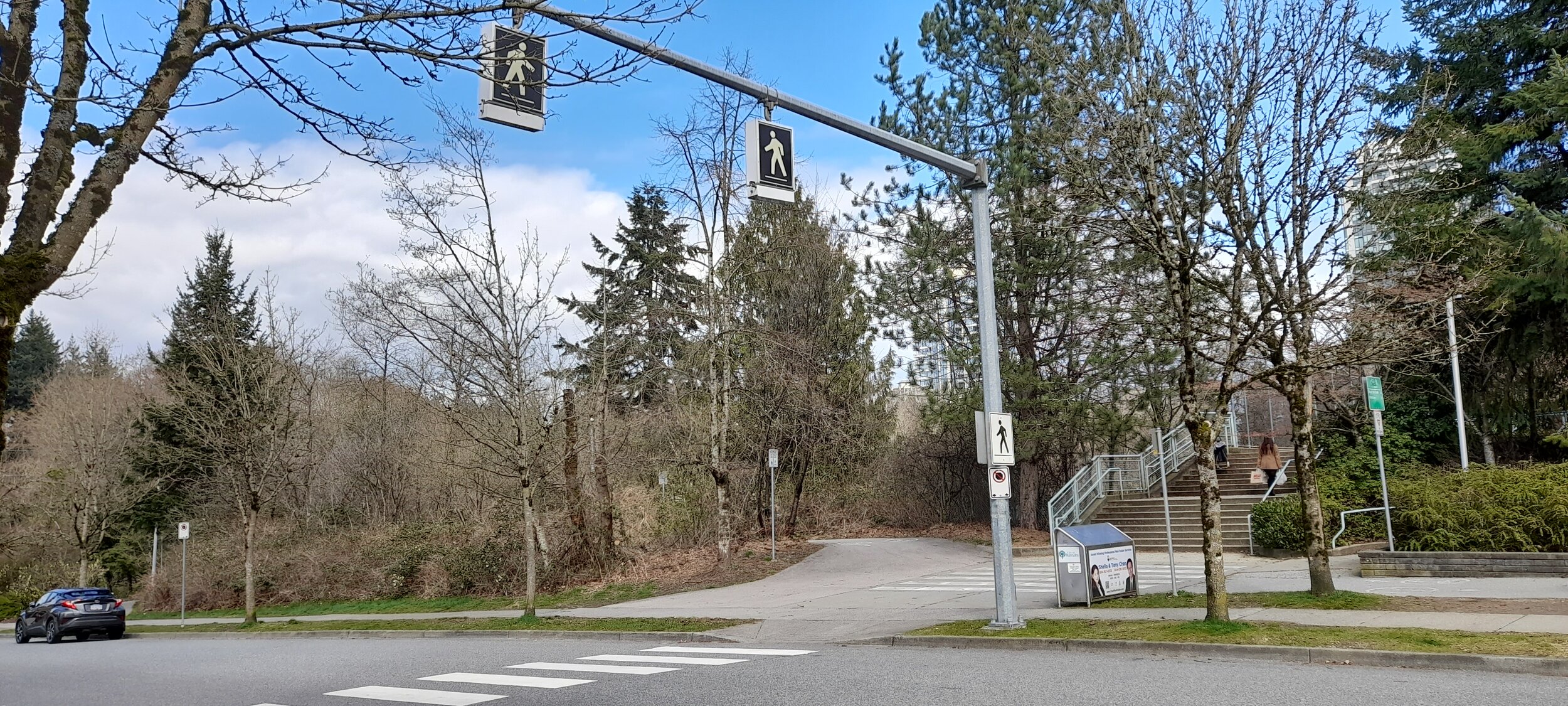
All the intersections with the road are well indicated and traffic wasn’t especially dense or fast.
On your left, you will see directions to Byrne Creek Secondary. If you hear some train track noises from behind the blackberry bushes, it’s from the SkyTrain maintenance and operations center located there.
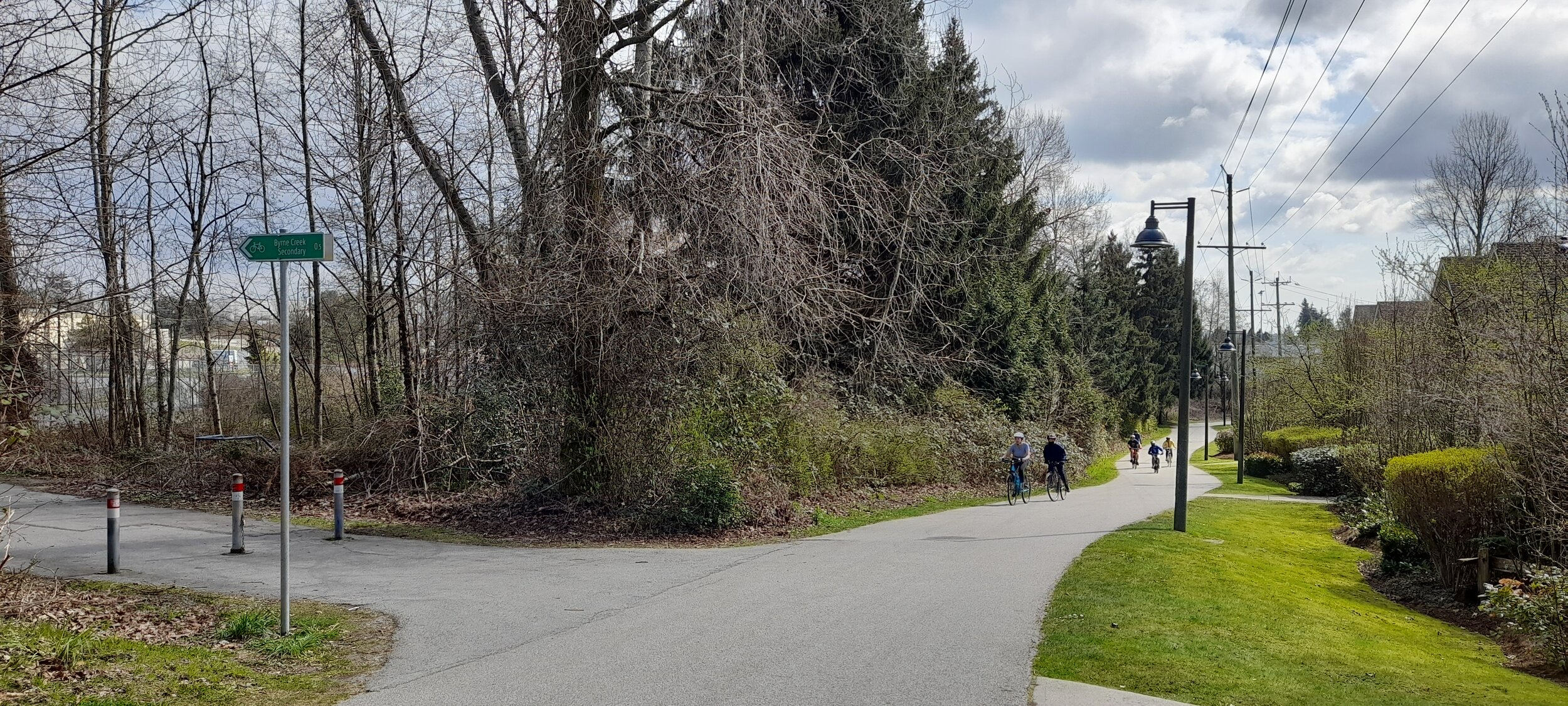
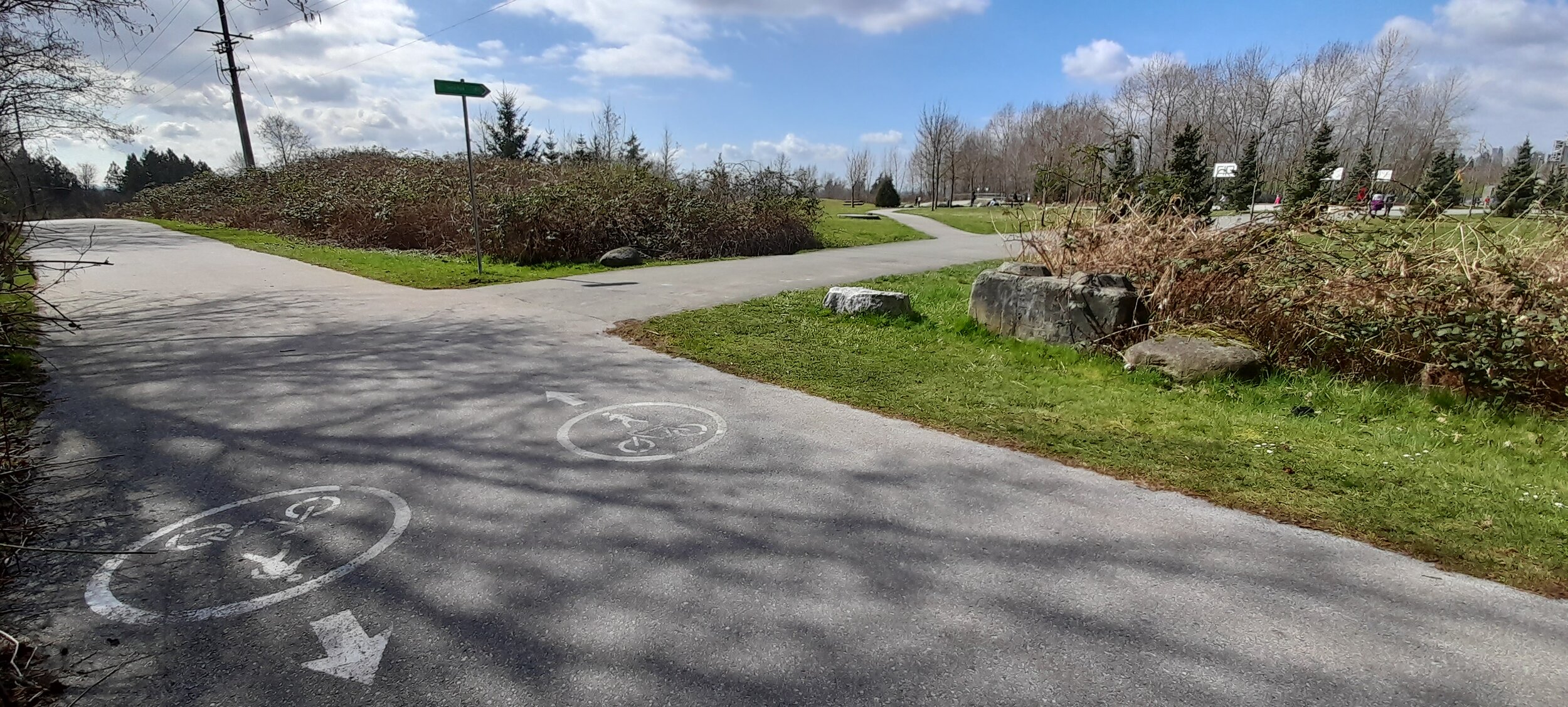
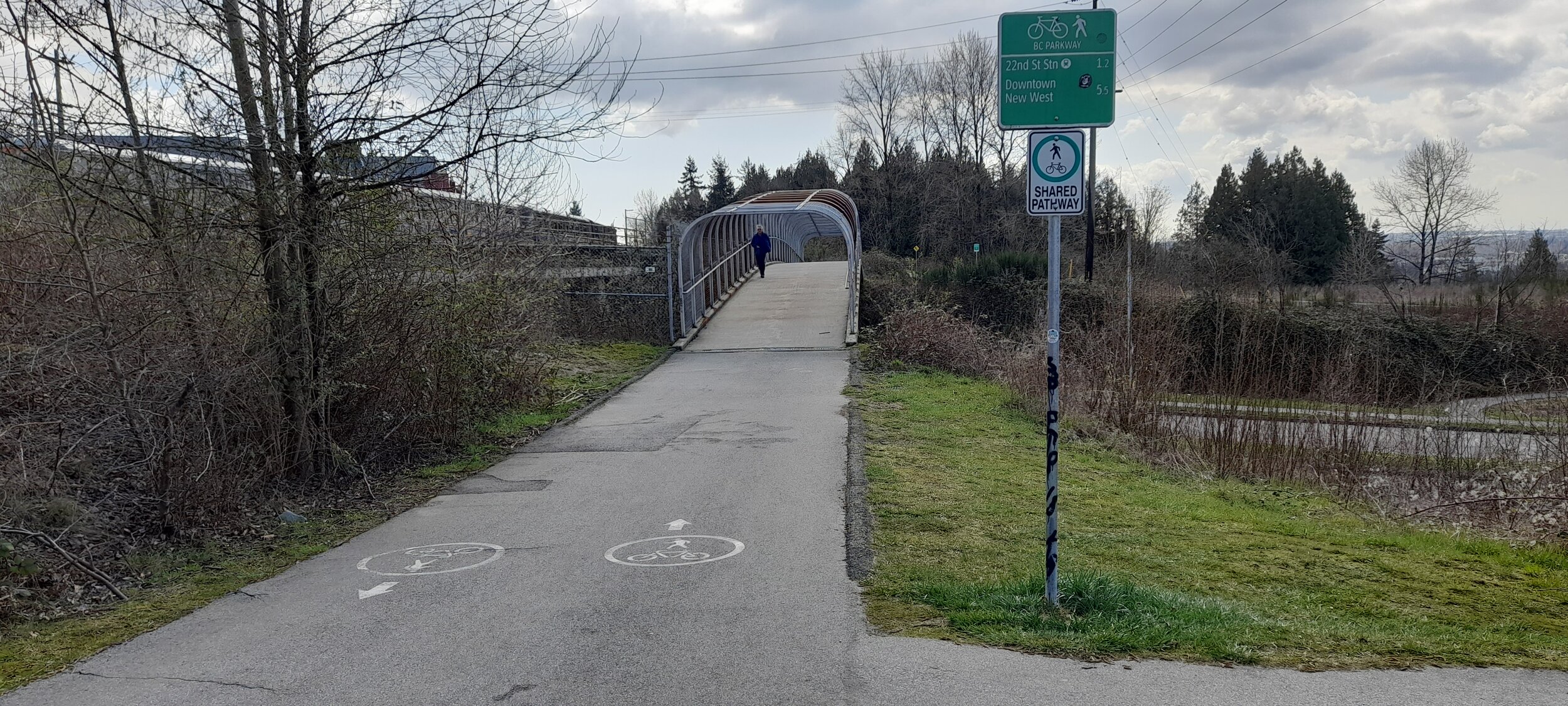
We kept walking towards Taylor Park which can be quite busy with school kids during their break time. There’s a well equipped playground in the area along with off-leash area for our four-legged friends.
We followed some of the trail and just managed to have a peek at the Byrne Creek urban trail, but it’s a nice long nature walk, highly recommended for enjoying some fresh air. Plan your leisure time well and you’ll have a great experience!
For our return journey, we took the bus route #100. It is located at Southridge Dr and Byrnepark Dr. The #100 also is the first route where TransLink has one of its first battery-electric buses running on trials. In January, they announced that they are incorporating another 15 such buses. Preserving this pristine nature walk to the fullest with zero-emission transit, we love Metro Vancouver!
Take a look at the virtual tour.
Happy Walking!
This blog post is written by BEST’s Isabel Garcia. #walkability
Neighborhood walking tour - Promising developments in Burnaby
Burnaby is a lovely, growing city witnessing so many new developments. In this walking tour, we took a short walk-hop-SkyTrain from Gilmore to Brentwood Town Center (Millennium line). So many developments coming up, so we thought of checking out the neighborhood.
Burnaby is a lovely, growing city witnessing so many new developments. In this walking tour, we took a short walk-hop-SkyTrain from Gilmore to Brentwood Town Center (Millennium line). So many developments coming up, so we thought of checking out the neighborhood. For starters, every new building is putting their piece of sidewalk and bike patch which is welcome.
Talk about creating denser cities, towers in Brentwood (50+ floors) can potentially accommodate an ‘entire village’. Planning the mobility needs for that many people can quickly get challenging, especially if everyone needs to travel in their own car. Thankfully, this neighborhood is so well connected by transit, that any travel need can be met with a quick walk-transit combo. Thanks to TransLink! And the City of Burnaby is taking steps to ensure convenient and safe connectivity - walk, roll and cycle friendly.
Apart from a hub for bulk shopping (Home Depot, Walmart etc.), the area is a hub for technology. In less than 15mins from Brentwood Town Centre SkyTrain station you could be at the BCIT campus with route 25 bus (which also connects to Burnaby Hospital). With such great connections, we recommend you leave your cars behind and explore this friendly town with a short pleasant walk.
Cycling infrastructure is quite improving in Burnaby. The city just finished 19 quick fixes last year and was quite deservingly felicitated with the #1 spot in the HUB Bike Awards for the 20-in-20 Infrastructure Challenge category. Way to go City of Burnaby! These new developments that we toured, as mentioned earlier, are making efforts to include walking, cycling ways around (needs improvement, but a great start).
The route we took is quite away from most of the noisy streets, so if you find yourself deterring walking around this neighborhood because of the noise levels - pick our route. We did the route and fully recognize that it’s not very pleasant right now because of the construction and it’s promisingly getting there, but it will serve you as a walk nonetheless without the need to drive somewhere else for it. The terrain is paved and mostly flat for a walk under 2 km. Convenient, also on a wet day (like the one we ended up picking).
Our route starts at Gilmore Skytrain station heading South. One of the first things you will notice are the train tracks crossing, which occasionally annoy with the loud noise, but kids love it. Moreover, consider watching the train from the green space in the nearby Jim Lorimer Park. The park playground has a nice set of slides too. All the more reason for that short family-time walk.
The City of Burnaby considers taking steps to help its residents get closer to nature and is investing in the Gilmore Urban Trail, part of the Central Valley Greenway.
Once out of the trail there are two options to access Willingdon Avenue: one with a flight of stairs along Still Creek Drive and the other right across which requires crossing traffic. We of course opted for the former as it is more accessible. The sidewalk is a little narrow compared to the others, but enough for a person-a-time to pass, and you’ll come up to the bridge over the train tracks now. At the end of our route, is the Brentwood Town Centre Skytrain Station. Most walking routes end up turning out to be a lot different in reverse, but this one was almost the same. There’s a park near this SkyTrain station. The reverse route has several more benches along the walkway and more green space for you to stretch your legs.
Happy walking!
This blog post is written by BEST’s Isabel Garcia. #walkability
Walking over the Inlet- Thank you SeaBus!
Keep reading to find out how easy and seamless the trip can be from Waterfront in (Vancouver Downtown) to Lonsdale Quay (North Vancouver).
It is winter on the West Coast and that means occasionally we have beautiful, dry sunny days. We know that you are as excited about sustainable transportation as we are, so we thought of sharing another experience on public transit with yet another walk ‘n transit tour.
Did you know? With a single tap of your Compass Card, you can travel not only on the Skytrain but take the SeaBus as well! In just 12mins, you can be on the other side of the Vancouver Harbour without thinking traffic delays and parking troubles.
Keep reading to find out how easy and seamless the trip can be from Waterfront (Vancouver Downtown) to Lonsdale Quay (North Vancouver).
The access to the SeaBus Terminal is integrated with the Waterfront SkyTrain Station. The visual indications are clear and quite easy to follow. There are screens showing how much time you have until the next vessel leaves (yes, a countdown!).
Unless you’re rushing, walk slowly through the corridor, enjoy the views of the Canada Place and the Gastown façades on either side. It can be as exciting and fun as walking above the city (quite literally). At the end of the corridor you can go down the escalators or head right, where there are two elevators. We (my toddler and I) took the new shiny elevator and it is all glass-walled (see through), so do not worry about feeling claustrophobic.
Most of the passengers will go through the turnstile and if you are in a wheelchair or with a baby-stroller, the staff will open the big doors for you. (Public transit can be so fancy). Once all the (arriving) passengers have exited the vessel, your boarding doors will be opened. Wait patiently in this boarding area, it won’t be long.
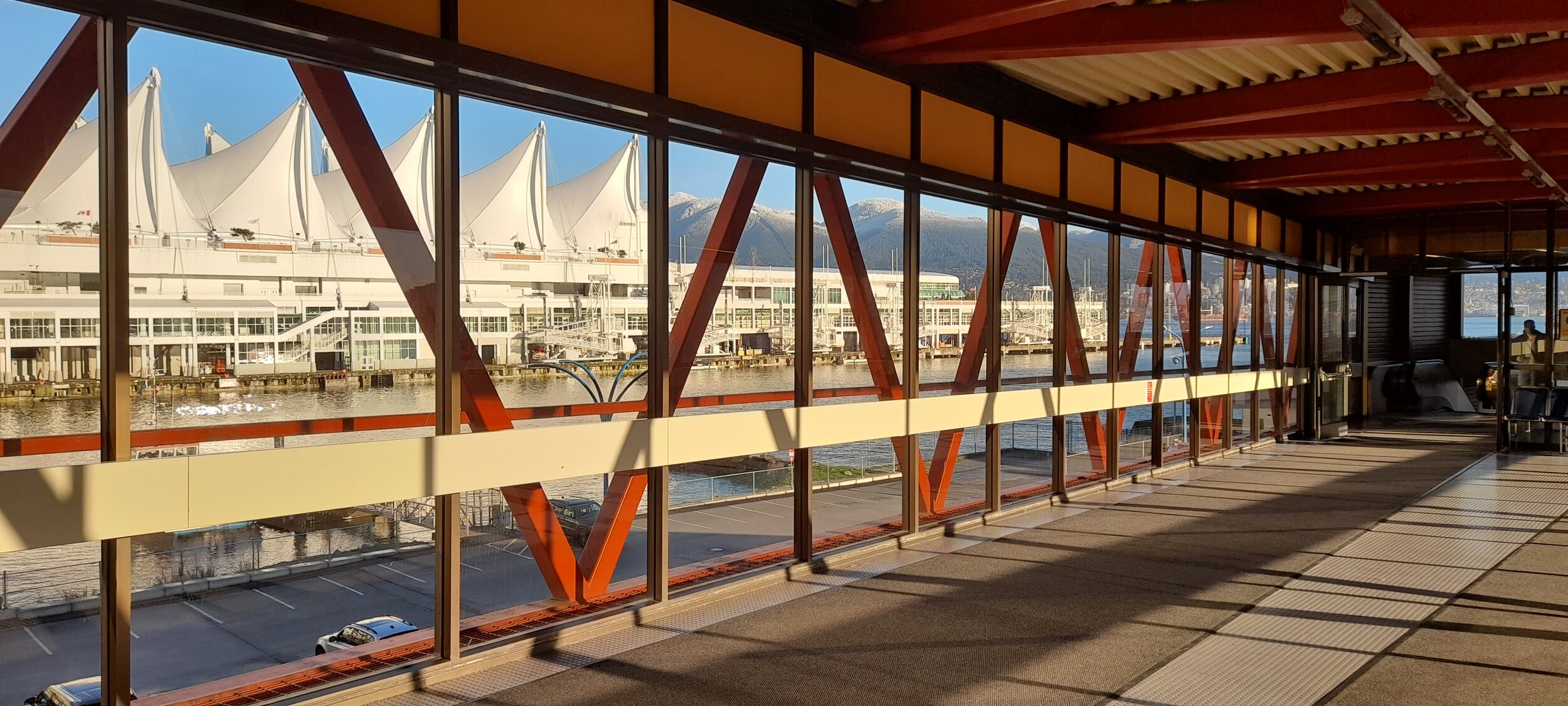
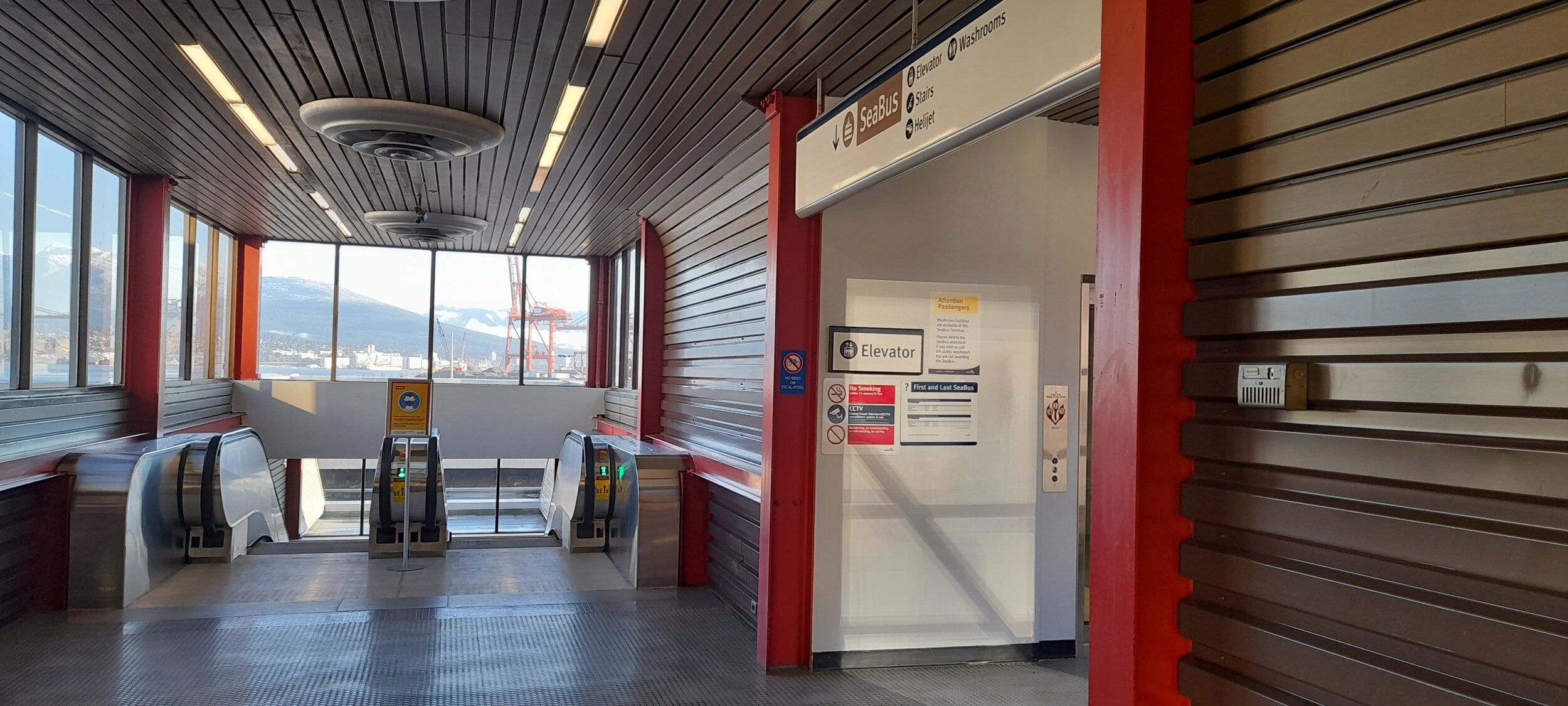
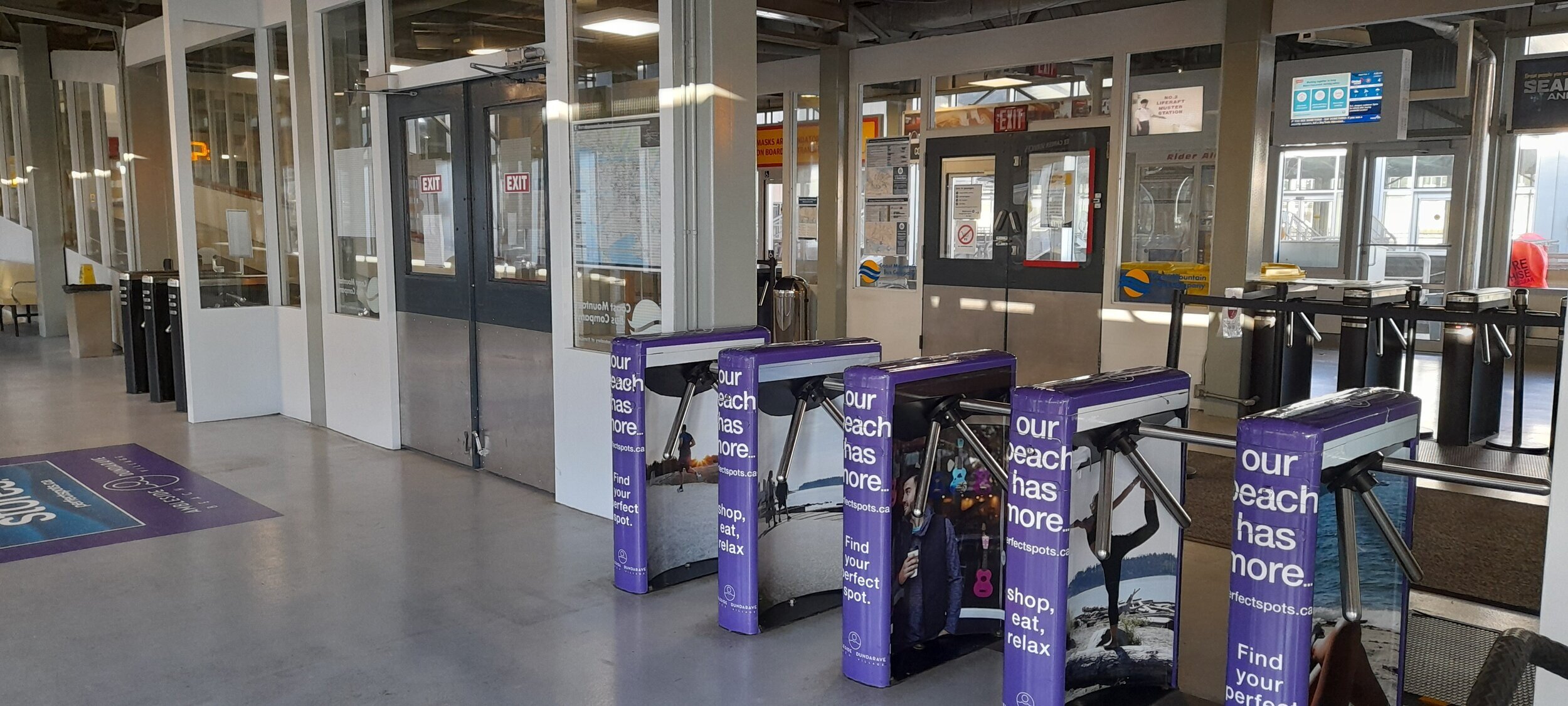
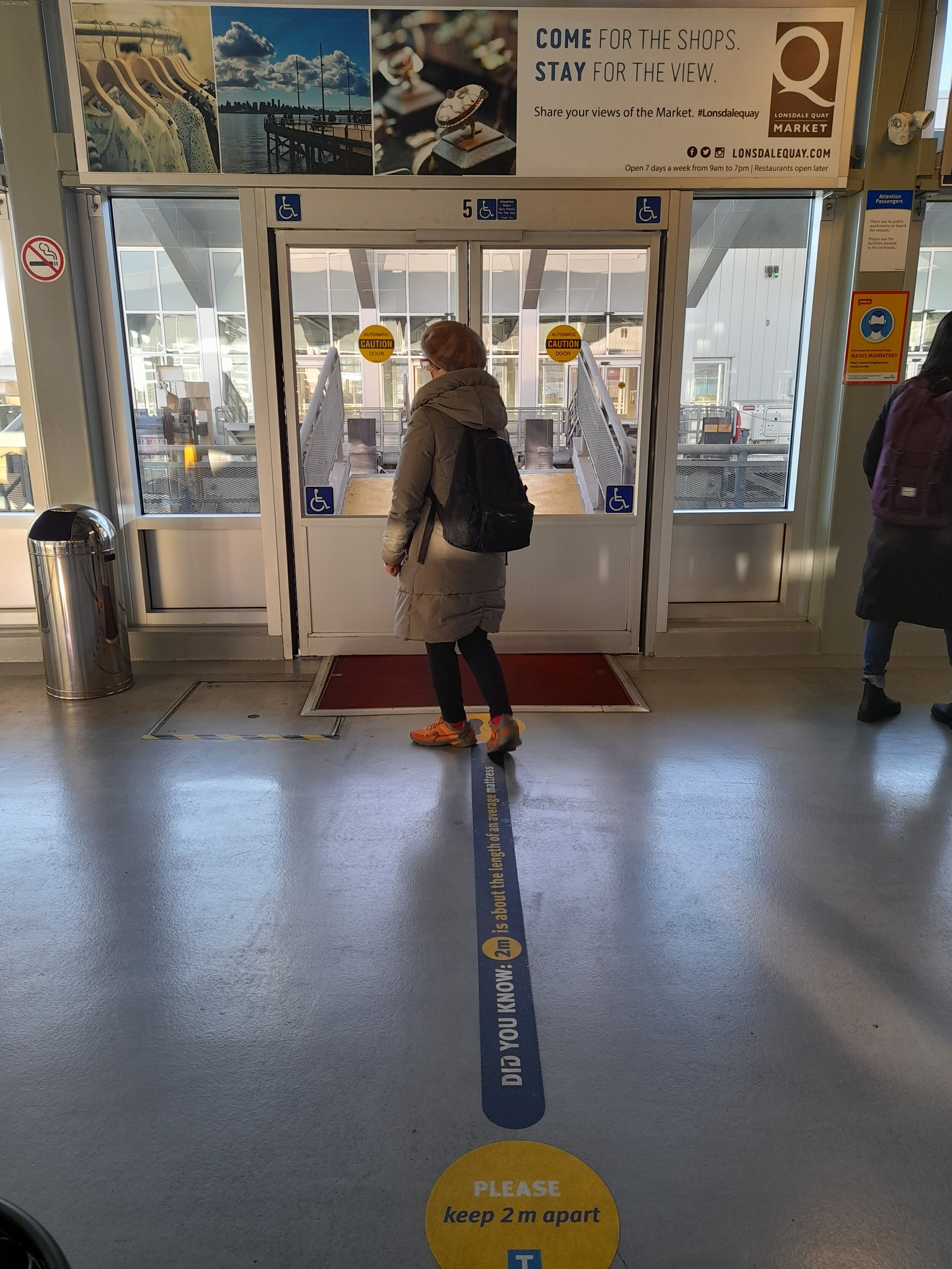
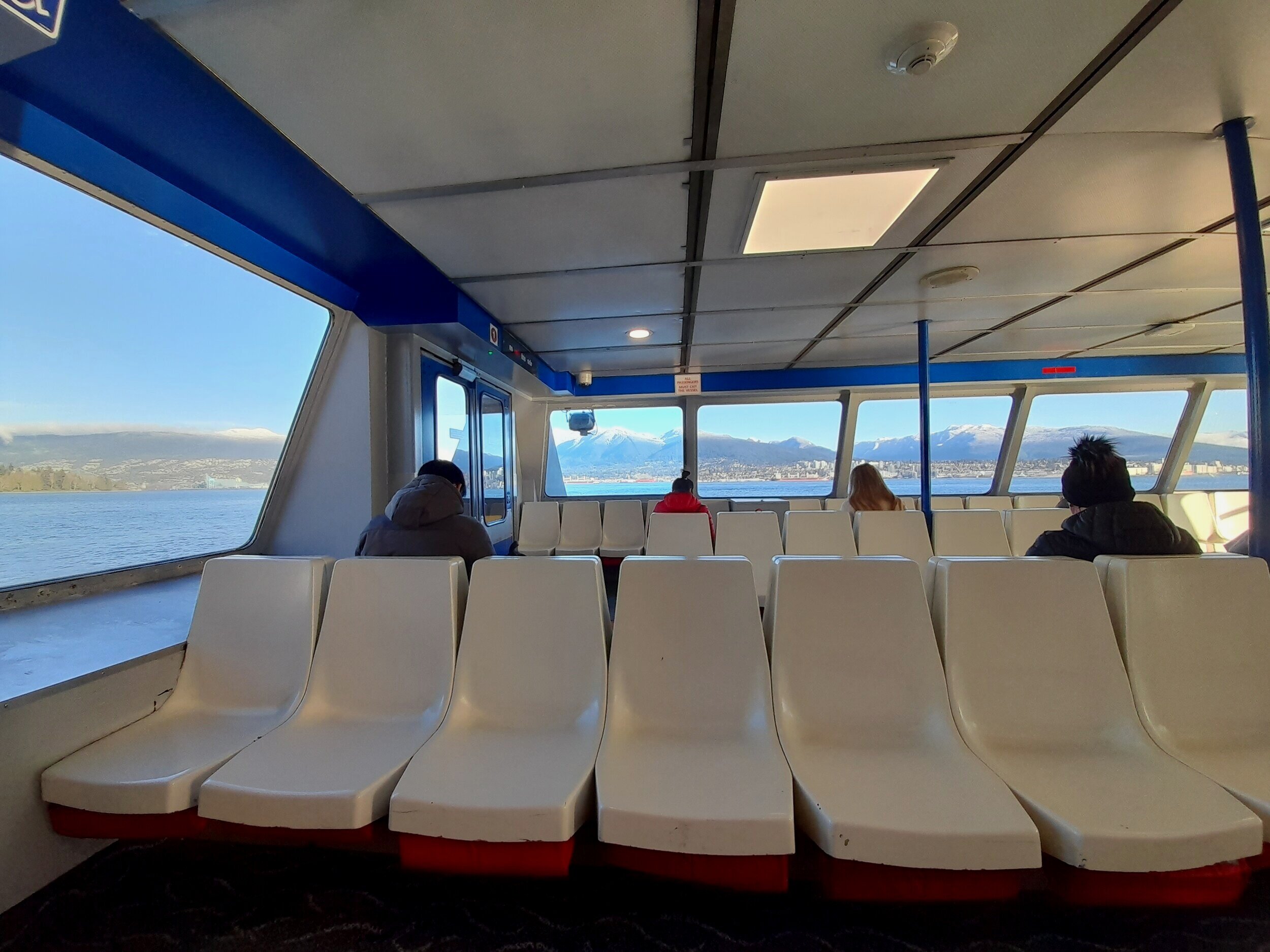
When inside the SeaBus, if you board by the doors marked as accessible, there is a space for placing the stroller without blocking any seats. Put on your (stroller) brakes, sit’n relax, enjoy the views on your way to North Van. In this short ferry ride you will be treated to the breathtakingly beautiful views of the Lions Gate Bridge, the forever lovely Stanley Park, the snow capped mountains...need I say more!
As soon as you arrive in North Vancouver, onward you go with the next part of your trip to Lynn Valley or Grouse Mountains or other North Vancouver destinations via bus connections at the exchange depo. Turn right on to the Lonsdale Quay Market and you can enjoy a short walk along the newly renovated public space.
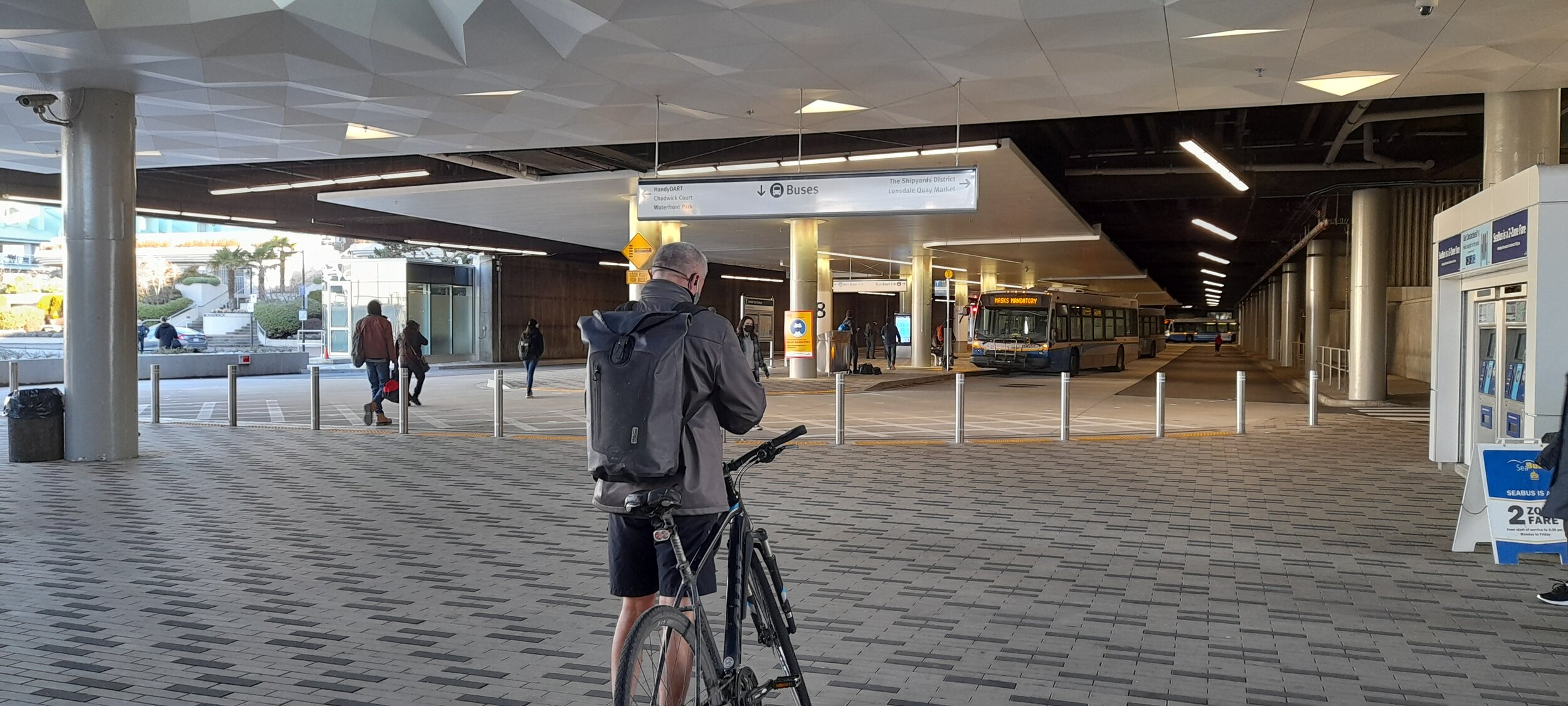
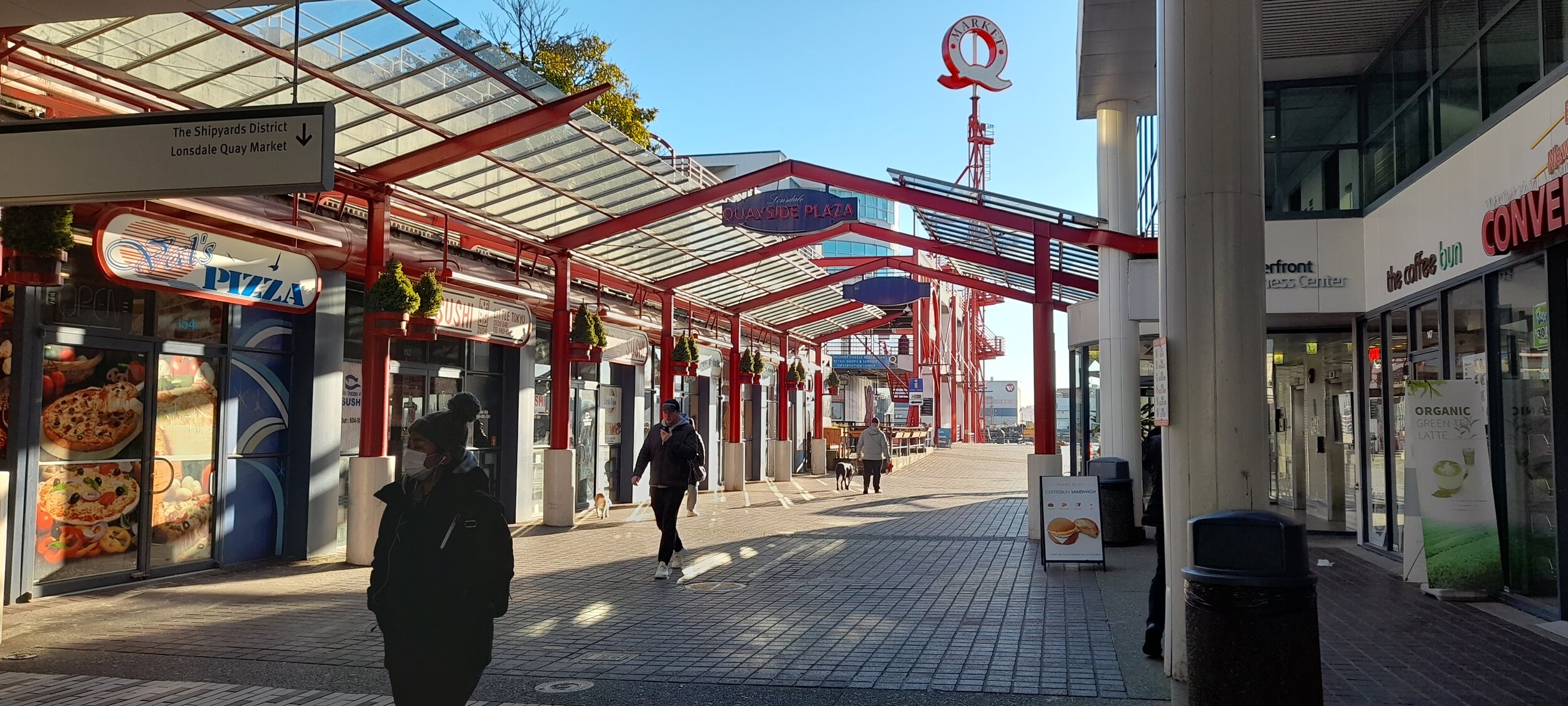
With a glorious sunny morning right in the middle of a Canadian winter, we couldn’t pass on the temptation to take a stroll. We walked at toddler pace enjoying the crisp views of Vancouver skyline and the mountains. Heading back, we took delight in this waterfront while we were waiting for the SeaBus to arrive. It is easy to see the vessel approaching and it only takes a couple of minutes to board again. Do not panic if you miss one. There’s one in every 15mins!
Happy walking!
This article is written by BEST’s Isabel Garcia. #walkability
The State of Cycling in Metro Vancouver
On February 28, 2020, HUB Cycling released Benchmarking the State of Cycling in Metro Vancouver, an in-depth report developed in partnership with all Metro Vancouver municipalities and TransLink, the regional transit authority, to provide a snapshot of the extent and quality of the region's bikeway network.
HUB Cycling releases ‘Benchmarking the State of Cycling in Metro Vancouver’ report
Developed in partnership with all Metro Vancouver municipalities and TransLink, the regional transit authority, the State of Cycling report provides a snapshot of the extent and quality of the region's bikeway network.
Over 18 months in the making, the State of Cycling does more than just provide an up-to-date picture of the lower mainland's route infrastructure.
The report shows that in areas where the network has grown and improved, the rate of collisions involving people who cycle has dropped, and cycling trips have increased significantly. It also suggests that where cycling rates are highest, local economies are strongest, pollution and greenhouse gas emissions from transportation are lowest, collision rates involving vulnerable road users are lowest, and health outcomes are the best.
What else does the State of Cycling have to tell us about the growth of cycling in Metro Vancouver?
The region is home to approximately 16,000 bikeways, totalling 4,600 km (almost 200% growth since 2009)
Approximately half of all regional bikeways are rated "Comfortable for most"
From 2006-2016, the region saw a 35% increase in the percentage of commuters who cycle
Among 23 local governments, Vancouver rated highest for ‘supportive policies and practices’’; Surrey boasted the highest proportion of the region’s bikeways (25%)
In addition to providing useful and easy-to-read graphs and charts chronicling the state of Metro Vancouver’s cycling facilities and opportunities for growth, the report also includes a new, standardized bikeway ‘quality ranking’ classification system, and a glossary of bikeway facility types.
Courtesy of HUB Cycling.


